The Rolex GMT-Master II Ref 16710 is an interesting watch. Coming to market in 1989, it remained in production for close to twenty years. By all accounts it was a strong seller for Rolex. Which means today there are quite a few in circulation. Or, put another way, it’s not what collectors would term “rare”. Likewise, there’s nothing that significant about this reference. Other than the fact that this would be the last time we saw the Coke bezel in production. And yet, it holds its own on the secondary market. So, is it a good watch to buy or not?
A (Very) Brief History Of The GMT-Master II
No doubt you’re already familiar with the backstory of the GMT-Master. Intercontinental travel by commercial airlines starting to become a thing in the 1950s. Pan-Am Airways needing a watch for its pilots that could display more than one time zone. And Rolex answering that call with a simple yet elegant solution. A stylish tool watch with a fourth hand on its dial, which pointed to a 24-hour scale shown on a rotating bezel. With said bezel divided in half by a two-tone colour scheme; blue and red. A visual separation of the daytime from nighttime hours.
- An early Rolex GMT-Master 1675 Pepsi.
It was a practical and ingenious design and one that Rolex has rarely deviated from. Other than to introduce different color schemes. Such as on the ever-popular Batman. Or the lesser known but no less cool Coke. In fact, the Coke bezel – half red, half black – made its debut at the same time as the GMT-Master II collection in 1983.
The first model in the new collection was the infamous Ref 16760. Also known as the “Fat Lady”. A not so kind reference to the model’s thicker case. This was to accommodate the new movement inside. The Calibre 3085, which introduced a quick-set jumping hour function. This allowed for the independent setting of the home and local time. A feature that had been lacking on the GMT-Master.
This wasn’t the only update to appear on the Ref 16760 though. It can also lay claim to being the first Rolex GMT watch to feature a sapphire crystal. Complete with Cyclops over the date window. It was also the first GMT with white gold around the tritium luminescent hour markers. Two features we take for granted on the GMT-Master II collection today.
- Prime examples of the Ref 16760 Fat Lady – such as this one – are sought after by collectors. Image credit: Phillips
As is often the case with older Rolex models, this first run of the GMT-Master II was short lived. Its production life spanning a mere five years. Making it quite sought after by collectors these days due to its low volume. And historical significance. (Being the first GMT-Master II and the first appearance of the Coke bezel.). As another interesting aside, the Ref 16760 was only offered in one version. Stainless steel case. Coke bezel. And Oyster bracelet. Take it or leave it.
The following year, in 1989, Ref 16710 came on the scene. Unlike the Ref 16760 though, it came in a variety of options. Three steel models with your choice of the popular Pepsi bezel, as well as a Coke or full black variant. Along with the two-tone yellow gold and steel GMT-Master II Ref 16713. (Affiliate link.) Better known to collectors as the Root Beer. And the full yellow gold GMT-Master II Ref 16718.
The Rolex GMT-Master II Ref 16710
The Ref 16710 introduced some decent upgrades to the earlier Ref 16760. The big one was the inclusion of the new Calibre 3185. The same movement used in the Explorer II Ref 16750, which also made its debut in 1989. Both models would later upgrade to the Calibre 3186 but not until around 2006. This calibre was slimmer than the earlier 3085. Which meant the 40mm Oyster case could be slimmer too. An important tweak for a brand known for its ideal case proportions.
- The Pepsi bezel on the Ref 16710 in all its delicious glory. Image credit: Phillips
Another welcome move was the re-introduction of the Jubilee bracelet. The GMT-Master actually made its original debut on a Jubilee. (One of the reasons the current steel Pepsi is only available on that style of bracelet.) And so not having it as an option on the Ref 16750 was a sticking point for many. The Ref 16710 offered the best of both worlds though as you could also get it on an Oyster bracelet too.
Rolex must have been pretty happy with the Ref 16710 because it stayed in production until 2007. At which point the first ceramic bezel GMT-Master II came on the scene. That’s around 18 years if you’re too lazy to do the math. As a result, the luminescence used on the dials varied over the years. Earlier examples feature tritium before giving way to Luminova, and finally SuperLuminova.
- A fine example of a Rolex GMT-Master II 16710 with Coke Bezel. Image credit: Phillips.
There were other subtle tweaks and updates over the years too. Nothing major but enough to make a modern Ref 16710 look and feel different to one from the early 90s. Things like drilled lug holes and hollow end links on pre-2000(ish) models. As well as flip-lock clasps on newer versions. Although no glide-lock unfortunately.
Something else to keep an eye out for are so called “ghost” bezels. This refers to the colors fading on the aluminum bezel insert over time. It can look quite cool and is even considered desirable to some collectors. But there have been instances in the past where the ageing of the bezel was not genuine. Or it had some help in making it look a certain way. Same goes for case polishing. Most Rolex collectors will tell you they prefer an unpolished case. It’s a personal preference but over-polishing will hurt the watch’s value long term. In any event, to protect yourself always buy from a reputable dealer.
- An example of a Ref 16170 Pepsi with a faded or “ghost” bezel. Image credit: Phillips
Pricing & Availability
Like all steel Rolex models, the Ref 16710 has seen quite a bump in its value over the past few years. OG collectors will tell you that back in their day, they used to be able to pick these up for under $5k. But that was over a decade ago. Nowadays, you need to budget at least US$15,000 – $17,000 for a Pepsi version in good condition. You can expect to pay a little less for a Coke bezel – like this one from our retail partner WatchBox. (Affiliate link.) As well as for the all-black bezel Ref 16710. Although factors like age, condition and box and papers will all play a role. Case in point this Ref 16710LN from 2007. (Affiliate link.)
All that said, it’s not too hard to find a Ref 16710 in good condition. The close to twenty year production run means Rolex made a lot of them. The challenge is deciding which time period you want to buy from. Early models are on the cusp of qualifying as vintage Rolex. While newer models have the advantage of better tech.
Is It Collectible?
The GMT-Master II collection is one of Rolex’s most iconic and beloved. The Pepsi bezel in particular is recognisable on the wrist a mile away. As a result, it seems likely that most – if not all – references in this collection will appreciate in value. Whether you’ll see the same rate of growth as these past few years is anyone’s guess though.
- Some people prefer the understated elegance of the all black bezel. Image Credit: Phillips.
That said, the Ref 16710 is a great option if you’re looking for a steel GMT-Master II that you can wear as your daily. It’s still way cheaper on the secondary market than the current Ref 126710BLRO Pepsi. Although I must admit the latter is a superior watch in about every respect. Except if, like me, you don’t prefer shiny Ceramic bezels.
The Ref 16710 is also the last reference to feature the Coke bezel. At least for now. Every year Rolex fans hold their breath in anticipation that it will make a comeback in ceramic. But so far it never has. That said, if it does, you can be sure interest in the Coke bezel Ref 16710 will sky-rocket. Much like with the Rolex Kermit when the new Submariner came out. Plus, I’m a fan of the black and red bezel. You don’t see it as much on Instagram, etc. Which makes it kind of special. Whatever your preference, I remain convinced the Ref 16710 is a good watch to buy. In the right condition. At the right price. Of course.
Technical Specifications: Rolex GMT-Master II Ref 16710
- Case: Oyster – 40 mm – Oystersteel – monobloc middle case, screw-down case back and winding crown – rotating bezel with 24-hour scale in Pepsi, Coke or full black color way – twin-lock double waterproof crown – waterproof to 100 metres / 330 feet.
- Dial: Black – arrow-tipped 24-hour hand in red – 18ct gold hour markers – Tritium, Luminova or Superluminova paint for illumination (depending on serial).
- Movement: Calibre 3185 or 3186 – bidirectional self-winding via Perpetual rotor – Parachrom hairspring (3186 only) – 48-hour power reserve – Centre hour, minute, seconds and 24-hour hands – Stop-seconds for precise time setting – COSC-certified chronometer.
- Price: discontinued/ ~USD 14,000 – USD 17,500 preowned depending on model and condition.
This article by TheWatchLounge has been sponsored by our partner WatchBox.
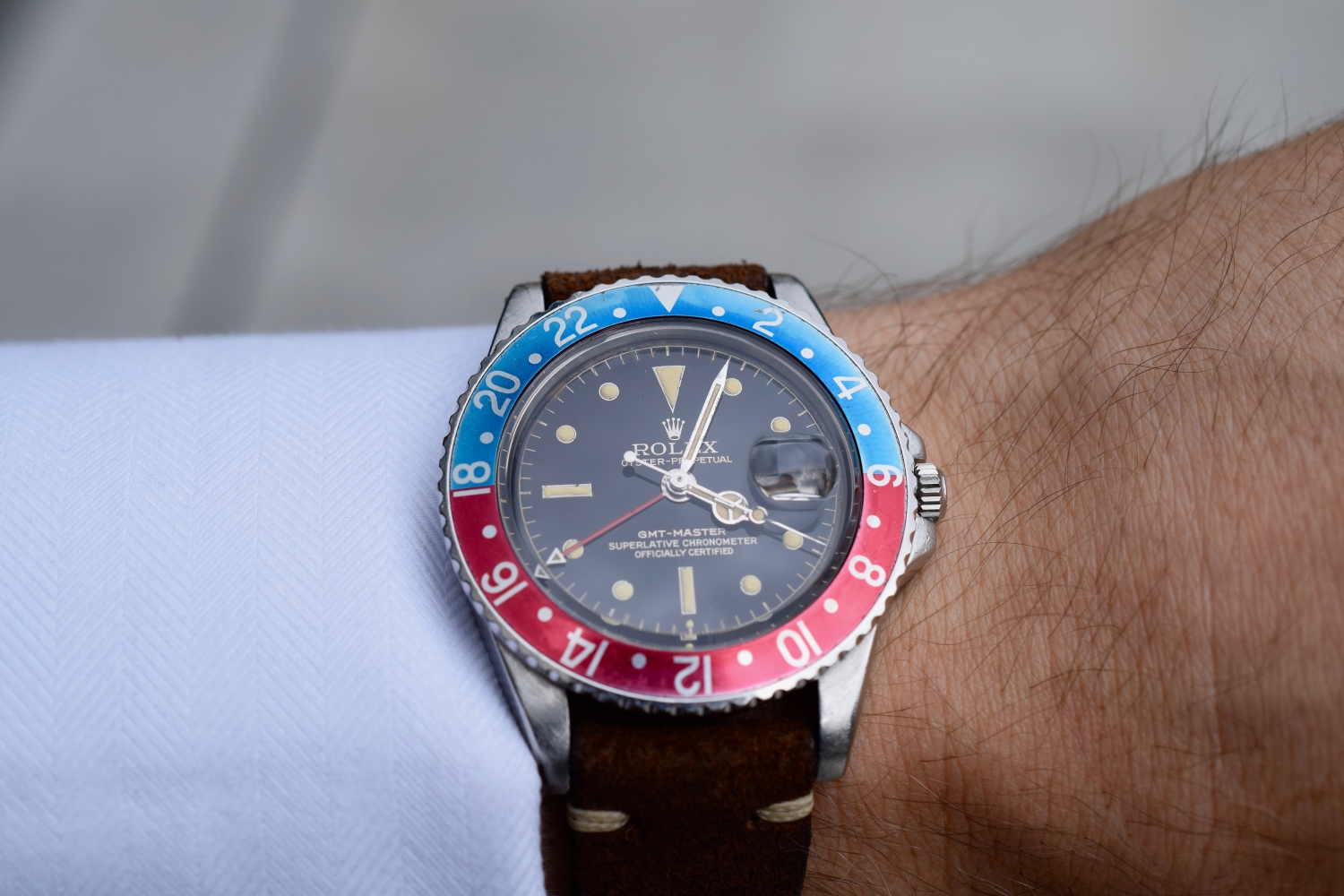
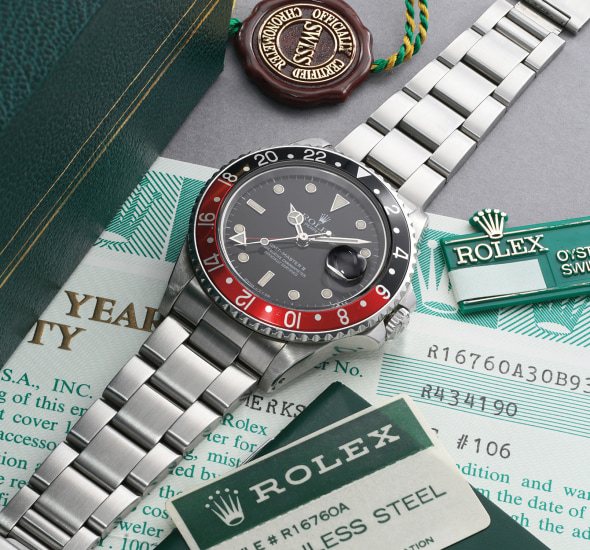
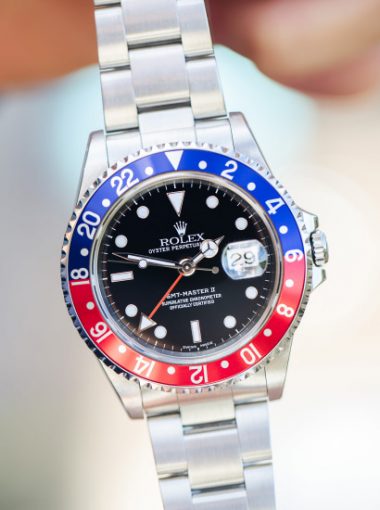
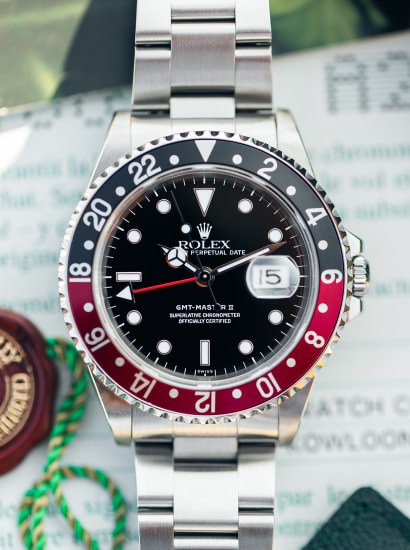
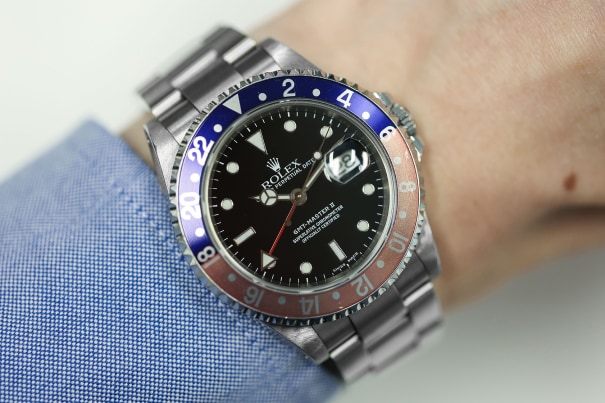
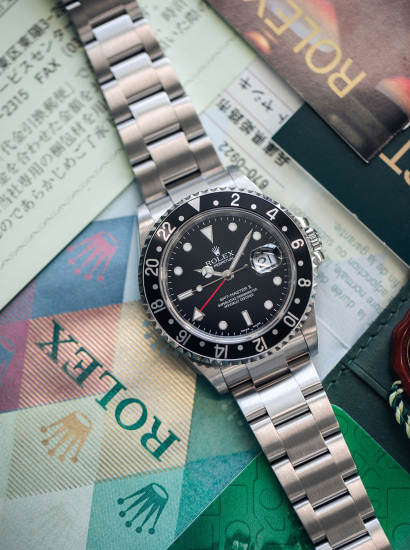
Tom,
I loved your article on 16710 gmt’s. I own an f serial, but I recently found an s serial, 1993 production, sold 1997, with certificate. The issue: it has the fatter case. Is it possible for a 1993 S serial to have the fatter case? It is at a reputable jeweler, but my research cannot verify authenticity. May I trouble you to provide your thoughts?
My best. Roy Boyd